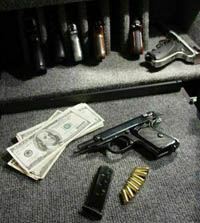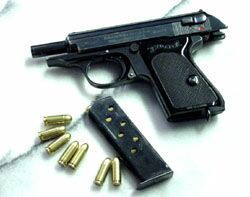The Carl Walther Waffenfabrik weapons factory was established in 1886, but did not begin to make self-loading pistols until 1908. Its first nine pistols were numbered, but in 1929 it produced a tenth model designed specifically  for police work which was designated the 'Polizei Pistole' or 'PP'.
for police work which was designated the 'Polizei Pistole' or 'PP'.
The Walther PP was immediately popular, and two years later a smaller version was produced for concealed use. It was intended for plain clothes and undercover police work and was designated 'PPK', which stands for 'Polizei Pistole Kriminal'. Although a good gun in its on right, the PPK gained world-wide notoriety when it became associated with Ian Flemming's legendary spy character, James Bond - agent 007.
A major turning point took place in the history of Walther's model PPK when Ian Fleming and Glasgow guns expert Geoffrey Boothroyd consulted to select a firearm to replace James Bond's inadequate .25 Beretta.
Introduced in the 1958 book and subsequent movie, 'Dr. No', their selection of the PPK led to its becoming a household name forever linked with 007. The PPK remained 007's trusty sidearm through 29 years of books and movies until the 1997 movie 'Tomorrow  Never Dies', where it was finally replaced by a 9 mm Walther P99.
Never Dies', where it was finally replaced by a 9 mm Walther P99.
The PPK is the same as the PP except that the barrel has been shortened. The internal mechanism is the same, however the parts that are affected by size were of course different. The most significant change is in the frame. The total length of the PPK is 5.8 inches. The magazine holds one less cartridge. The barrel has six clockwise riflings. The back strap has been eliminated. They utilized a wrap-around plastic grip to give the frame a corrected contour. Although not the first, the PP and PPK pistols were two of the earliest pistols designed with double-action triggers, and as such employ slide mounted decocking levers. This allowed for safe carrying of the weapon with a chambered round.